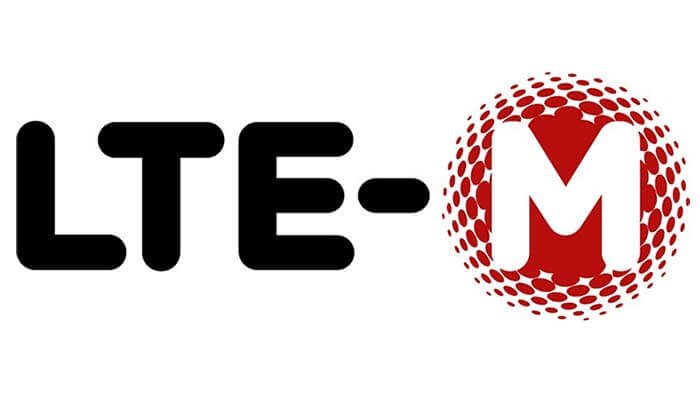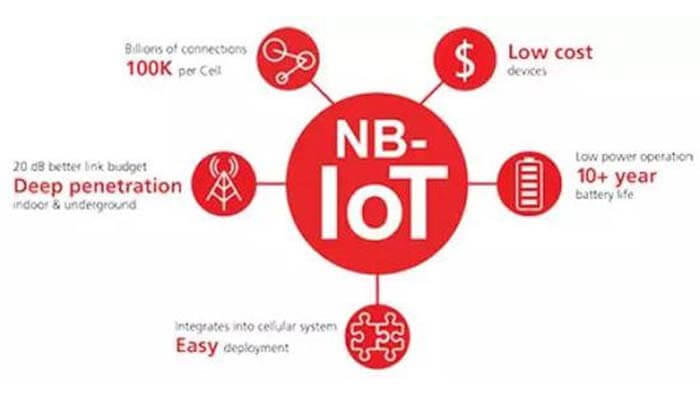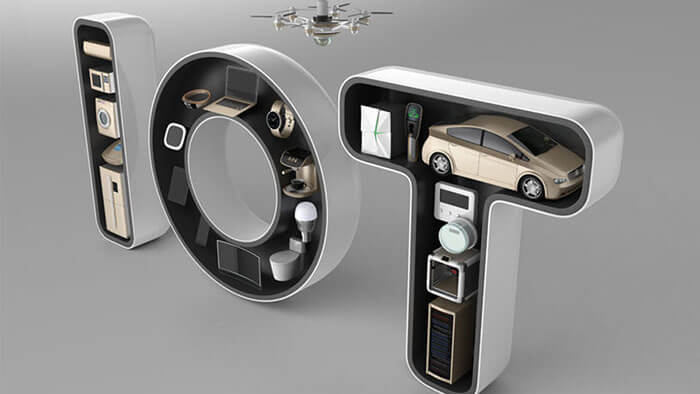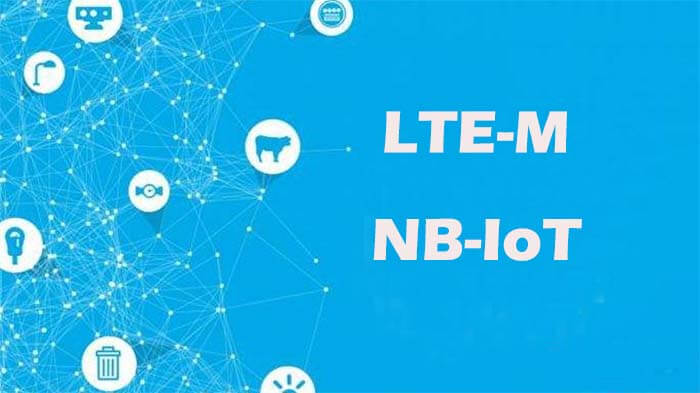What are the differences and relationships between LTE-M and NB-IoT?

What is LTE-M?
LTE-M, or LTE-Machine-to-Machine, is an LTE evolution-based IoT technology, called Low-Cost MTC in R12 and LTE enhanced MTC (eMTC) in R13, designed to meet the needs of IoT devices based on existing LTE carriers.
The full name of eMTC is enhanced Machine-Type Communication. It is the LTE network between machines using LTE communication for the IoT. It is often abbreviated as M2M.
A response to the growing interest in IoT and LPWAN, LTE-M is unique in that it can be very energy efficient and transmit up to 10 bytes of data per day, but can also transmit up to one megabit per second. LTE-M serves a very wide range of use cases.
Advantages of LTE-M
LTE-M has a higher data rate than NB-IoT. This makes LTE-M a richer solution set, as it will offer the widest range of cellular features.
While LTE-M allows you to reach very high data rates, you can benefit from new architectures such as eDRX and PSM, which can also help you benefit from the same power budget as NB-IoT or Sigfox.
LTE-M will benefit from reduced complexity. For example, Verizon has a single spectrum for LTE-M in the US, which brings a lot of complexity to their LTE-M solutions. This allows for very simple front-end and antenna configurations.

What is NB-IoT?
NB-IoT refers to Narrow Band – Internet of Things (NB-IoT) technology. It can be deployed in three ways, coexisting with existing networks.
The full name of NB-IoT is Narrow Band Internet of Things (NB-IoT).
Built on cellular networks, NB-IoT consumes only about 180 kHz of bandwidth and can be deployed directly on GSM, UMTS, or LTE networks to reduce deployment costs and enable smooth upgrades.
In August 2015, 3GPP RAN started a project to study a new air-port technology for narrowband radio access called Clean Slate CIoT, a Clean Slate solution covering NB-CIoT.
NB-CIoT was jointly proposed by Huawei, Qualcomm, and Neul, and NB-LTE was proposed by Ericsson, Nokia, and other manufacturers.
NB-CIoT proposes a new air interface technology with relatively large changes to existing LTE networks, but NB-CIoT is the only one of the six Clean Slate technologies proposed that meets the five major objectives (improving indoor coverage performance, supporting large-scale device connectivity, reducing device complexity, reducing power consumption and latency) set out in the TSG GERAN #67 conference.
Cellular IoT technologies, in particular NB-CIoT, have lower communication module costs than GSM modules and NB-LTE modules.
NB-LTE prefers to be compatible with existing LTE and its main advantage is its ease of deployment.
Eventually, after discussions at the RAN #69 meeting in September 2015, a consensus was negotiated that NB-IoT can be considered a convergence of NB-CIoT and NB-LTE.
Narrowband IoT (NB-IoT or LTE Cat-NB1), which does not operate in an LTE configuration. It is based on the advantages of DSSS modulation.
NB-IoT consumes the least amount of power while operating. Almost all IoT technologies save power when they are not running because they are “sleeping”.
But when the modem is running and handling all the signal processing, NB-IoT technologies with simpler waveforms will consume less power.
Note: Not all NB-IoT modules have the same characteristics. Some NB-IoT modules are designed to transmit as many signals as possible and have an external power supply, so there is no need to focus on power.
NB-IoT components are much cheaper. Chips supporting NB-IoT are cheaper compared to those supporting LTE-M because they are easier to build. 200 kHz NB-IoT front ends and digitizers are much simpler than 1.4 MHz LTE resource blocks.
In addition, processing OFDM in LTE requires more power than, for example, simpler waveforms for NB-IoT.
The NB-IoT standard, formerly known as LTE-M, was officially announced by the ITU in September 2015, renaming LTE-M to NB-IoT (narrowband Internet of Things).
LTE-M was introduced by the 3gpp organization in the LTE release 13 version, and its three features of low power consumption, low transmission rate, and high coverage meet the needs of low-power IoT, and this standard can be understood as based on the cat.0 standards developed in 3gpp organization release 12 version.
In fact, compared to the previous cat.1~cat.10, the release 12 version of cat.0 is not designed to be classified as a measure of traditional cellular networks, but rather for the IoT.
Cat. x refers to UE-category, which is separate, UE is user equipment and category means classification, so intuitively, the value of Cat. x is used to measure the wireless performance of user-end devices and is used to classify the endpoint rate (class).
According to the 3gpp release, UE-category is divided into 10 categories from 1 to 10, with Cat.1 to Cat.5 in the R8 group, Cat.6 to cat.8 in the R10 group, and Cat.9 to Cat.10 in the R11 group.
Cat.0 is directed towards the broad IoT market, enabling lower power and lower cost IoT devices to connect to the LTE network. Supporting the lower categories is critical for IoT applications such as wearables, smart homes, and smart meters.

How are IoT technologies classified?
In general terms, IoT technologies are divided into two broad categories: WLAN IoT (short-range) and cellular IoT (long-range).
WLAN IoT: represented by Wi-Fi, Bluetooth, Zigbee, and Z-wave.
Cellular IoT: represented by NB-IoT, eMTC, LoRa, and Sigfox.
LTE-M and NB-IoT are cellular IoT technologies, which also belong to LPWAN technology (Low Power Wide Area Network).
What are the relationships between LTE-M and NB-IoT?
In 2008, the 3GPP version R8 of LTE had Cat.1 for “low rate” applications such as IoT. The peak rate of Cat.1 was only 5Mbit/s and was not noticed by the industry. That refers to as eMTC.
In addition, 3GPP added a new Cat.NB-1 in R13, which has a reception bandwidth of only 180 kHz. This Cat.NB-1 is now NB-IoT.
According to a recent study by the Global Mobile Suppliers Association (GSA), 102 operators in 52 countries around the world have deployed or launched Low Power Wide Area Networks (LPWANs) based on LTE-M and NB-IoT, with 20 of them adopting both standards and over 140 operators continuing to invest in LTE-M and NB-IoT to support future IoT devices and applications.
LTE-M for multiple applications, NB-IoT for durable high penetration.
Both LTE-M and NB-IoT are LPWAN technologies defined by 3GPP, the organization responsible for LTE and 5G NR standards, in its Release 13 standard.
The two technologies LTE-M and NB-IoT complement each other to a certain extent, with some of the differences in characteristics being a point of consideration for enterprises.
Latency refers to the time it takes to enter the network and send a message, allowing devices to collect information at intervals and then transmit packets to the cloud or communicate in real-time performance. NB-IoT can be used for timed monitoring devices such as smart water meters, which are also more durable due to their lower power consumption.
What are the differences between LTE-M and NB-IoT?
The main difference between LTE-M and NB-IoT is the ability to transmit voice in addition to data. It is worth noting that although LTE-M technology supports voice transmission, it is up to each operator to decide whether to implement it on its network.
Transmission speed is another key technology choice, as higher speeds mean more data can be transmitted over the network in a given time, which is particularly important for data-intensive IoT applications such as home security and wearable devices.
In terms of technology, LTE-M terminals support a larger bandwidth, offering transmission rates of up to 1Mbps much greater than the peak upstream and downstream rates of NB-IoT, thus allowing for more data throughput.
In terms of device location, both technologies offer several times the transmission range of traditional LTE, but NB-IoT has the ability to propagate over long distances through walls and metal conduits, thus offering better penetration than LTE-M indoors and under the ground.
LTE-M, on the other hand, can be used on the move due to its ability to switch between different base stations, and its greater mobility allows the technology to be used in connected vehicles, trackers, etc.
LTE-M and NB-IoT technologies have their own advocates, but parallelism may be the future
In addition to the characteristics of LTE-M and NB-IoT specifications, the deployment of regional operators is also a consideration for enterprise technology adoption.
The US is more supportive of LTE-M as Verizon and AT&T have invested heavily in their LTE networks; in addition, Bell Canada and Spark New Zealand are also single adopters of this technology.
As each technology is suitable for its own application, some operators offer both LTE-M and NB-IoT for enterprises to choose from, such as Chunghwa Telecom and APSTAR in Taiwan, SoftBank in Japan, and Telstra in Australia.
For example, Vodafone uses LTE-M in New Zealand and the Netherlands, while the remaining 12 countries such as Greece and Germany deploy NB-IoT; Orange offers LTE-M in France and Romania, and both technologies in Belgium.
According to the GSMA report “LTE-M and NB-IoT in the context of 5G”, a total of 43 commercial LTE-M and NB-IoT networks had been launched by the end of March 2018. The global trade paper organization highlighted the role of mobile IoT in enabling use cases such as the development of smart cities and industrial automation.
“The LTE-M and NB-IoT deployed today are part of the 5G family,” the GSMA wrote. “As the 5G era dawns, here’s how LTE-M and NB-IoT technologies are becoming an integral part of 5G.”
3GPP completed Release 15 which means LTE-M and NB-IoT will co-exist with other 3GPP technologies and meet long-term 5G LPWAN requirements.
LTE-M supports lower device complexity, massive connection density, low device power consumption, and low latency and provides wider coverage while allowing the re-use of LTE installed bases.
NB-IoT features improved indoor coverage, support for a large number of low throughput devices, low latency sensitivity, ultra-low device cost, low device power consumption, and optimized network architecture.
Low power consumption has been an issue for many mass-market IoT deployments and as such it meets the needs of many IoT solutions and environments that require a longer duration, lower power consuming devices, which can require a longer payback period.
Overall, LTE-M offers lower latency, higher speed, mobility, and VoLTE voice calls in applications, while NB-IoT has the advantages of lower cost, longer service life, and wider transmission range, so there is no absolute preference between LTE-M and NB-IoT technology choices. The future trend of dual technology LTE-M and NB-IoT in a single region is in the making, relying on application scenario design and business requirements to enable enterprises to make the most suitable LTE-M and NB-IoT technology adoption.
Besides the LTE-M and NB-IoT Relationships article, you may also be interested in the below articles.
What Is The Core 5G NR Technology?




